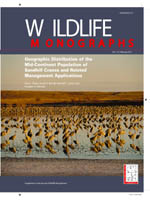The Mid-continent Population (MCP) of sandhill cranes (Grus canadensis) is widely hunted in North America and is separated into the Gulf Coast Subpopulation and Western Subpopulation for management purposes. Effective harvest management of the MCP requires detailed knowledge of breeding distribution of subspecies and subpopulations, chronology of their use of fall staging areas and wintering grounds, and exposure to and harvest from hunting. To address these information needs, we tagged 153 sandhill cranes with Platform Transmitting Terminals (PTTs) during 22 February—12 April 1998–2003 in the Central and North Platte River valleys of south-central Nebraska. We monitored PTT-tagged sandhill cranes, hereafter tagged cranes, from their arrival to departure from breeding grounds, during their fall migration, and throughout winter using the Argos satellite tracking system. The tracking effort yielded 74,041 useable locations over 49,350 tag days; median duration of tracking of individual cranes was 352 days and 73 cranes were tracked >12 months. Genetic sequencing of mitochondrial DNA (mtDNA) from blood samples taken from each of our random sample of tagged cranes indicated 64% were G. c. canadensis and 34% were Grus canadensis tabida. Tagged cranes during the breeding season settled in northern temperate, subarctic, and arctic North America (U.S. [23%, in = 35], Canada [57%, n = 87]) and arctic regions of northeast Asia (Russia [20%, n = 31]). Distribution of tagged cranes by breeding affiliation was as follows: Western Alaska—Siberia (WA—S, 42 ± 4% [SE]), northern Canada—Nunavut (NC—N, 21 ± 4%), West-central Canada—Alaska (WC—A, 23 ± 4%) and East-central Canada—Minnesota (EC—M, 14 ± 3%). All tagged cranes returned to the same breeding affiliation used during the previous year with a median distance of 1.60 km (range: 0.08–7.7 km, n = 53) separating sites used in year 1 and year 2. Fall staging occurred primarily in central and western Saskatchewan (69%), North Dakota (16%), southwestern Manitoba (10%), and northwestern Minnesota (3%). Space-use sharing indices showed that except for NC—N and WC—A birds, probability of finding a crane from one breeding affiliation within the home range of another breeding affiliation was low during fall staging. Tagged cranes from WC—A and EC—M breeding affiliations, on average, spent 25 and 20 days, respectively, longer on fall staging areas in the northern plains than did WA—S and NC—N birds. Cranes in the NC—N, WA—S, and WC—A affiliations spent 99%, 74%, and 64%, respectively, of winter in western Texas in Hunting Zone A; EC—M cranes spent 83% of winter along the Texas Gulf Coast in Hunting Zone C. Tagged cranes that settled within the breeding range of the Gulf Coast Subpopulation spent 28% and 42% of fall staging and winter within the range of the Western Subpopulation, indicating sufficient exchange of birds to potentially limit effectiveness of MCP harvest management. Harvests of EC—M and WC—A cranes during 1998–2003 were disproportionately high to their estimated numbers in the MCP, suggesting more conservative harvest strategies may be required for these subpopulations in the future, and for sandhill cranes to occupy major parts of their historical breeding range in the Prairie Pothole Region. Exceptionally high philopatry of MCP cranes of all 4 subpopulations to breeding sites coupled with strong linkages between crane breeding distribution, and fall staging areas and wintering grounds, provide managers guidance for targeting MCP crane harvest to meet management goals. Sufficient temporal or spatial separation exists among the 4 subpopulations on fall staging areas and wintering grounds to allow harvest to be targeted at the subpopulation level in all states and provinces (and most hunting zones within states and provinces) when conditions warrant. Knowledge gained from our study provides decision-makers in the Uni
How to translate text using browser tools
1 February 2011
Geographic Distribution of the Mid-Continent Population of Sandhill Cranes and Related Management Applications
Gary L. Krapu,
David A. Brandt,
Kenneth L. Jones,
Douglas H. Johnson
ACCESS THE FULL ARTICLE
It is not available for individual sale.
This article is only available to subscribers.
It is not available for individual sale.
It is not available for individual sale.

Wildlife Monographs
Vol. 175 • No. 1
February 2011
Vol. 175 • No. 1
February 2011
breeding affiliation
Central Flyway
fall staging areas
Grus canadensis
harvest
Mid-continent Population (MCP)
sandhill crane




